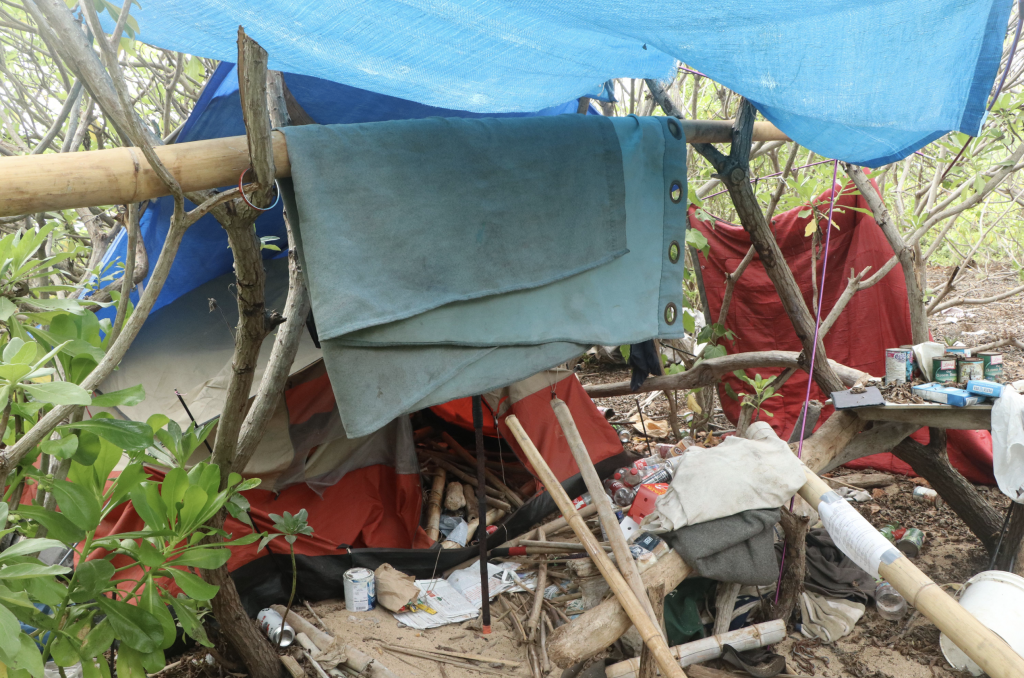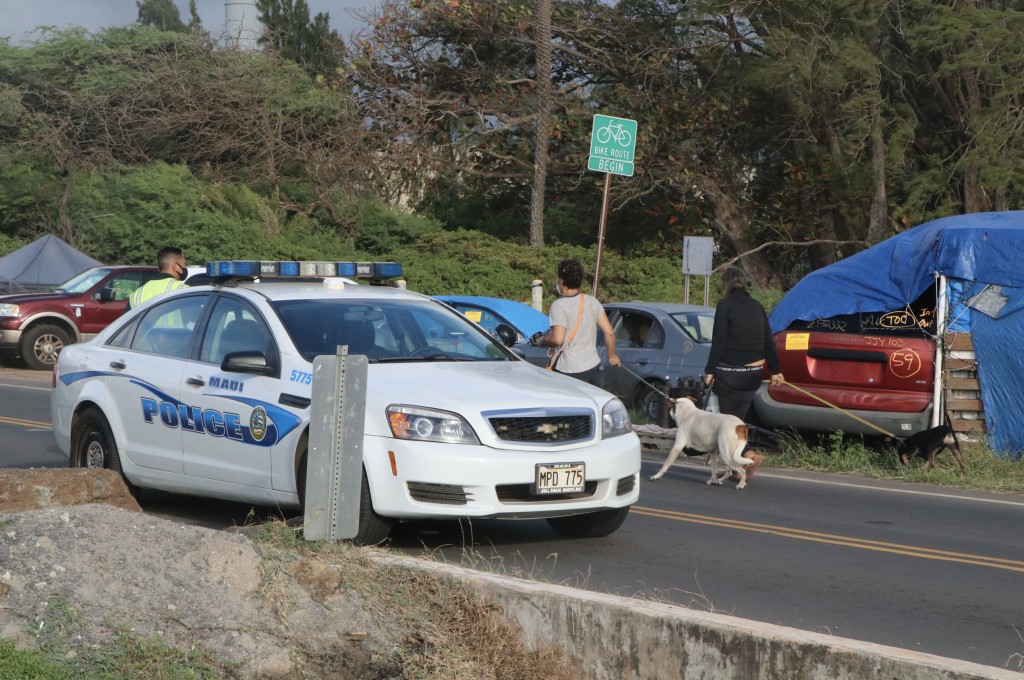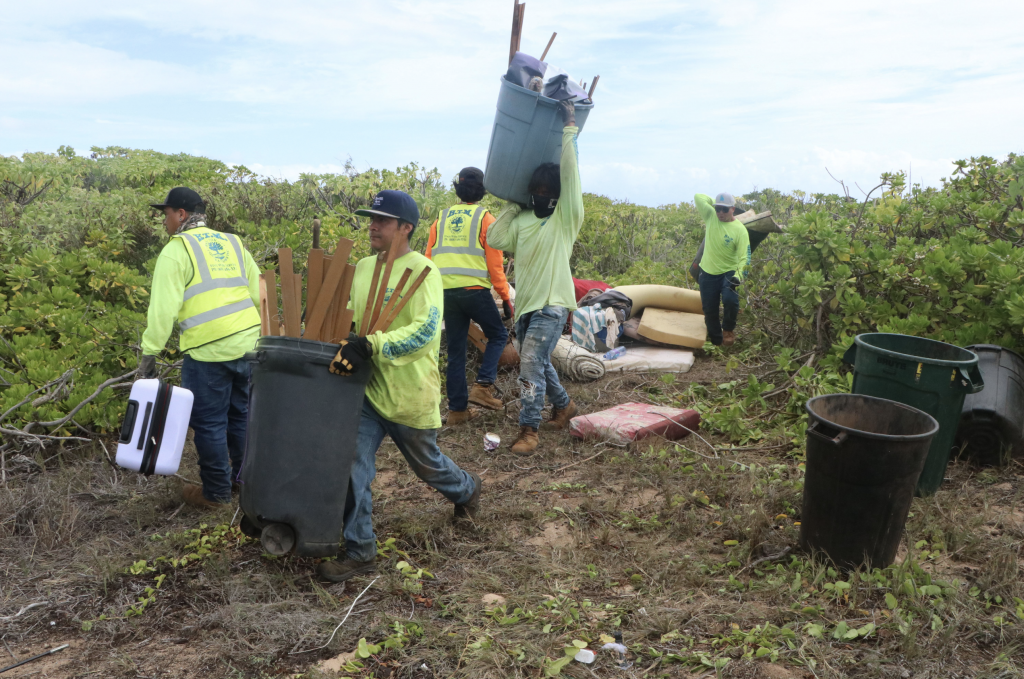Advocates for Unsheltered Houseless Residents Speak Out Against Amala “Sweep”

The county led cleanup effort of ‘Āmala Place in Kahului resulted in the removal of 58 tons of solid waste and 54 derelict vehicles this week, but not all are happy with the process and its impact on the unsheltered homeless individuals who were living in area encampments.
Kia‘i Pu‘uhonua O Kanahā, an all-volunteer advocacy group was formed in response to the situation, saying their efforts were in support of the encampment community and the local nonprofit Share Your Mana, which has served as a longtime advocate as well.
County officials called the living situation “unsafe” saying it had become a “public health hazard.” According to the latest county update, the deep cleaning also included a magnetic sweep to locate and remove “small metal objects such as hypodermic needles.”
Members of the group Kia‘i Pu‘uhonua O Kanahā called the cleanup a “sweep” saying residents of the encampment were given one week to relocate. The group claims the county’s actions during the effort violated the civil rights of Maui’s houseless residents.
The group also said that it put residents at risk by “ignoring stop demands from the American Civil Liberties Union of Hawai‘i and ignoring the recommendations of the Centers for Disease Control and Prevention during a pandemic with record-breaking numbers of COVID-19 cases in the Maui community.”

County officials say that in December of 2020, there were nearly 80 individuals who were living in the encampment along ‘Āmala Place. “We had been working with them pretty significantly since then,” said County Managing Director Sandy Baz during a media briefing on Friday afternoon. “Of course, the last six weeks, [that] has been enhanced, and social workers as well as the Department of Housing and Human Concerns have been down there pretty much every day,” he said, “working with them to help get them into housing.”
Those who accepted housing reportedly went to homeless shelters, temporary pallet housing at Waiʻale, the Hale A Ke Ola Homeless Resource Center, and the Family Life Center. Some moved into permanent housing and many moved in with families, according to a county update. “There were some that we were unable to provide shelter for. They refused the shelter that was offered to them,” said Baz.
The advocacy group has challenged the county’s response saying, “As of Friday morning, Sept. 24, there were about 10 residents whose access to shelter was not yet determined.”
Noelani Ahia, a volunteer community advocate with Kia‘i Pu‘uhonua O Kanahā said an estimated 90% of the unsheltered population living at Kanahā are kānaka maoli.
“It’s unconscionable that the people of this place are unhoused in their own homeland,” said Ahia. “There simply isnʻt enough shelter space or pallet homes available and some folks have circumstances that make the shelters not an option. The Mayor said he would work with those with extenuating circumstances who cannot go to shelters, some of whom he met in a meeting last Friday. He seemed to understand the complicated nature of their circumstances and said agencies would be available to help them.”
Ahia contends that “the help never came,” saying, “Many folks scattered immediately after law enforcement and work crews arrived on Monday, having suffered severe trauma from previous sweeps. It would have been far more prudent to make sure all of these folks were given options before the sweeps took place. Much of this distress could have been avoided,” she said.
Baz offers a very different outlook, describing the cleanup as “intensive and compassionate” work. He extended thanks to the agencies that helped to facilitate the effort.
Earlier in the week, Mayor Victorino said, “I understand how disruptive change can be… but I truly believe this is a change for the better for everyone concerned. Area occupants were able to get a new start in clean, safe accommodations with services to help them move ahead.”

Before the cleanup began, Mayor Victorino said, “Caring for people comes first. It’s not compassionate to enable people to continue living without basic sanitation. Mounds of rubbish, human waste and used syringes surround many of the tents and temporary structures in the area. With the risk of flooding during the upcoming rainy season, now is the time for these folks to move into emergency shelters.”
Lisa Darcy, founder of Share Your Mana confirms that there is a lack of housing at the moment to sufficiently meet the overwhelming need for the visible and hidden homeless on Maui to live sanitary and sustainable lives. Darcy estimates there may be as many as 1,000 hidden homeless on Maui. “Unhoused residents have circumstances and conditions which agencies cannot address due to the fact that they have not evolved their practices to meet the needs of all residents and to make current solutions more effective,” she said.
“This dialogue needs to be held in the larger context of affordable housing in a county with a median home price of over $1 million dollars,” said Darcy. “After the housing crash many years ago, the displacement of housed community members into rentals further exacerbated the housing inventory crisis. At that time, without the emergence of new, flexible entry points that incorporate mental health, addiction, and trauma-related needs, this crisis has bloomed into an overwhelming task. Maui’s housing crisis will continue to worsen without visionary leadership.”
Ahia said advocates have a sincere desire to take these lessons and create systemic change that will prevent such a sweep from happening again. “They want the larger community to know that these residents are regular people, just like you and I. They could be your mother, aunty, son or friend. Many of us are one paycheck, one illness, one disability away from being in this same predicament. Itʻs past time for Maui County to step up and acknowledge the humanitarian crisis the housing situation has created, and take action to reverse course.”
In addition to the affordability factor, advocates made claims of civil rights violations and worked with the American Civil Liberties Union, who sent letters to the office of Maui Mayor Michael Victorino, Maui’s Chief of Police, and other state and county officials on Tuesday, demanding that the sweep cease immediately.
The ACLU has been working to decriminalize poverty and on its website makes claims that during the pandemic, Maui and Hawai‘i counties have “handled houselessness in ways that are counterproductive, heartless, and constitutionally questionable.”
The group Kia‘i Pu‘uhonua O Kanahā contends that the effort was “confrontational, punitive, and not grounded in supportive, compassionate, person-centered approaches, which are necessary approaches for assisting those experiencing mental illness or addiction.”
Darcy with Share Your Mana said, “The case acknowledges those in poverty do not have equal access to due process. Maui continues to refuse to evolve, leaving the problems to multiply.”
More no-trespassing signs were installed on Friday along ‘Āmala Place and Baz said police are prepared to enforce that to prevent people from coming back.
“The ‘Āmala Place encampment impeded critical access to the state owned Kanahā Pond Wildlife Sanctuary and the county owned and operated Wailuku-Kahului Wastewater Reclamation Facility,” said Baz. “The encampment was a health and safety hazard that put both occupants and the general public at risk.”
Challenges and issues, associated with a large human presence right next to the sanctuary have increased in recent months, according to the state Department of Land and Natural Resources. According to DLNR, there has been human impacts on natural resources of the bird refuge for the last decade, but over the past year, it’s gotten much worse. Wildlife officials say they’ve been unable to do work like removing invasive weeds, because people have set up camp right next to the protective fence around the 150-acre sanctuary.
“No houseless person was arrested. None of their personal belongings were discarded or destroyed,” said Baz.
Darcy asserts, “these are all solvable equations and we will fight to insert practices which honor individual civil rights regardless of whether you are housed or unhoused. We must stay in a place of solutions.”










